

AI-Powered Medical Records Summarization: A Game-Changer






AI-powered medical record summarisation is transforming the way healthcare professionals interact with clinical data. Modern electronic medical records (EMRs) often contain voluminous, unstructured information such as physician notes, lab results, imaging reports, and discharge summaries.
Manually sifting through these records can be time-consuming, error-prone, and mentally exhausting for clinicians. By leveraging natural language processing (NLP) and machine learning, AI can rapidly extract the most relevant patient details, highlighting critical insights for faster review.
This not only reduces cognitive load on healthcare professionals but also enhances the speed and accuracy of clinical decision-making. A survey from TechRT reported that, as of 2025, 71% of U.S. healthcare systems deploy NLP to analyze EMRs, reducing clinical documentation time by 34% and achieving 91% extraction precision on unstructured clinical data.
This article explores the key benefits, real-world use cases, technical processes, and challenges of implementing AI medical record summarization.
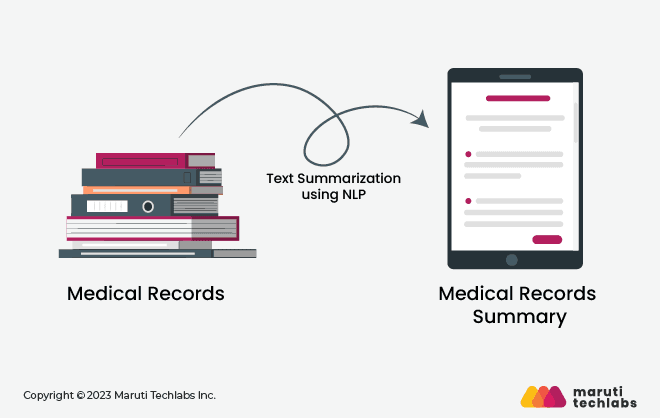
AI‑powered medical record summarisation uses natural language processing (NLP) and machine learning models to automatically extract and summarise key clinical information from EMRs/EHRs.
These systems identify diagnoses, medications, labs, history, and treatment plans, transforming lengthy clinical notes into concise summaries.
By leveraging advanced models or domain‑adapted LLMs, they preserve clinical meaning while eliminating redundancy, making critical information readily accessible to clinicians and administrative staff.
AI summarisation works through a structured workflow that combines natural language processing, machine learning, and domain-specific training.
It identifies relevant clinical information, condenses unstructured text into actionable insights, and ensures summaries are accurate, context-aware, and valuable for both clinicians and administrative teams.
Here’s how it does this following five easy steps.
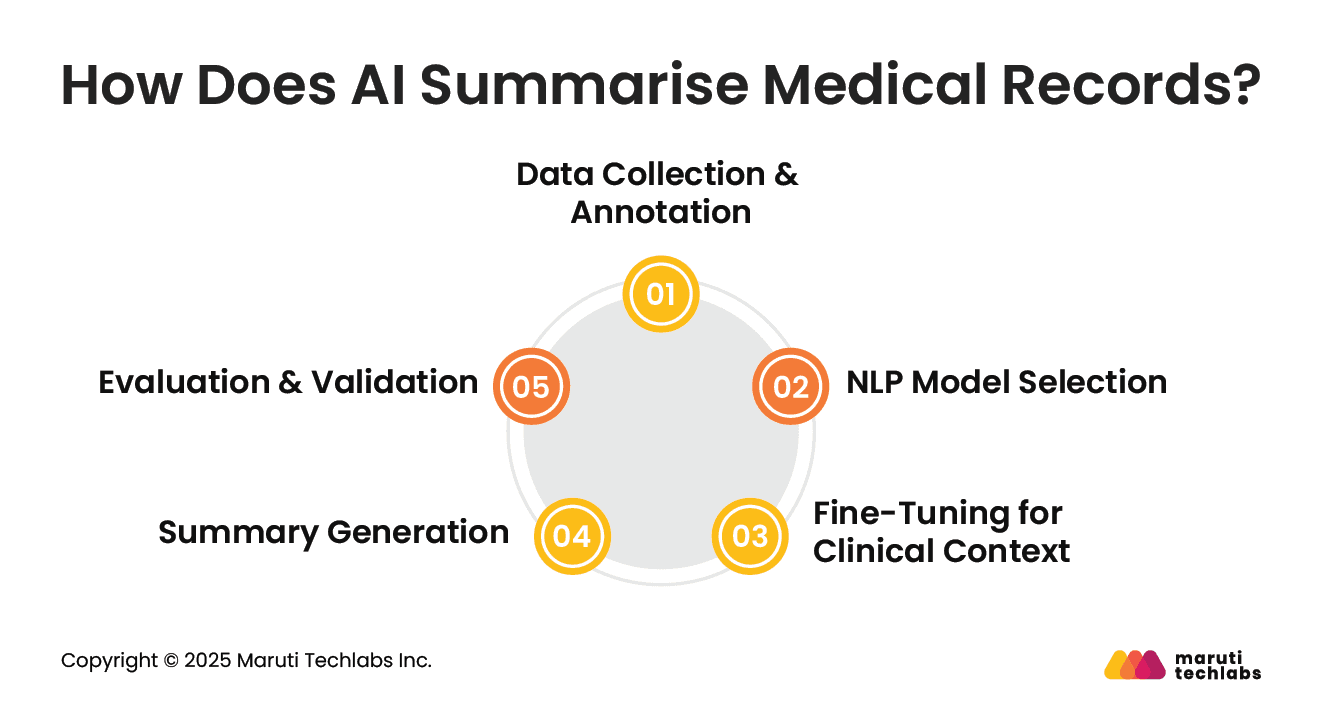
Clinical notes, lab reports, and discharge summaries are collected, cleaned, and annotated to train models for relevant information extraction.
Advanced models like Transformers, BERT, BioBERT, or domain-specific LLMs are selected to interpret medical text and capture context.
Models are trained on specialty-specific data to handle abbreviations, jargon, and nuanced medical terminology accurately.
Summaries are produced using extractive (selecting key sentences) or abstractive (rephrasing for clarity) methods.
Output is assessed using metrics like ROUGE or BLEU and reviewed by clinicians to ensure safety and reliability.
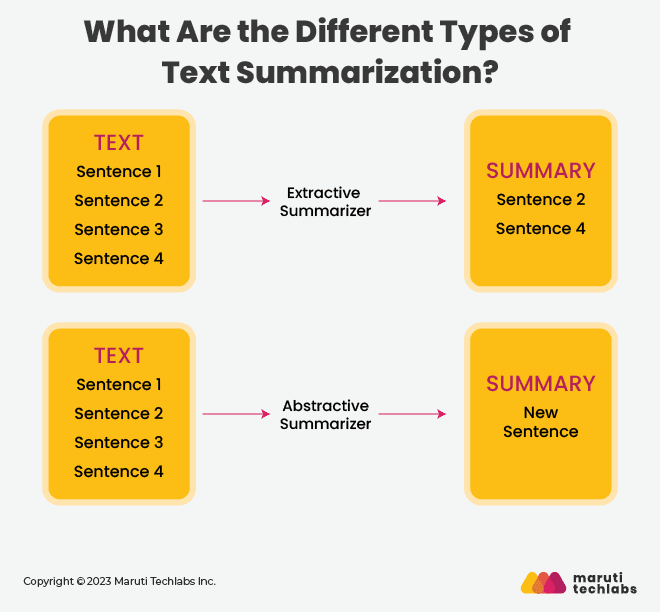
There are two main approaches to getting an accurate summary and analysis of medical records: extractive summarization and abstractive summarization.
Extractive summarization involves selecting essential phrases and lines from the original document to compose the summary. However, managing extensive and complex medical records with specialized terminology takes time and effort. LexRank, Luhn, and TextRank algorithms are among the top-rated tools for extractive summarization.
In abstractive summarization, the summarizer paraphrases sections of the source document. In abstractive summarization, the summarizer creates an entirely new set of text that did not exist in the original text. The new text represents the most critical insights from the original document. BARD and GPT-3 are some of the top tools for abstractive summarization.
When comparing abstractive and extractive approaches in text summarization, abstractive summaries tend to be more coherent but less informative than extractive summaries.
Abstractive summarization models often employ attention mechanisms, which can pose challenges when applied to lengthy texts.
On the other hand, extractive summary algorithms are relatively easier to develop and may not require specific datasets. In contrast, abstractive approaches typically require many specially marked-up texts.
AI summarisation reduces clinician burden and accelerates workflows by turning verbose clinical notes into actionable summaries, allowing healthcare teams to focus on care rather than documentation.
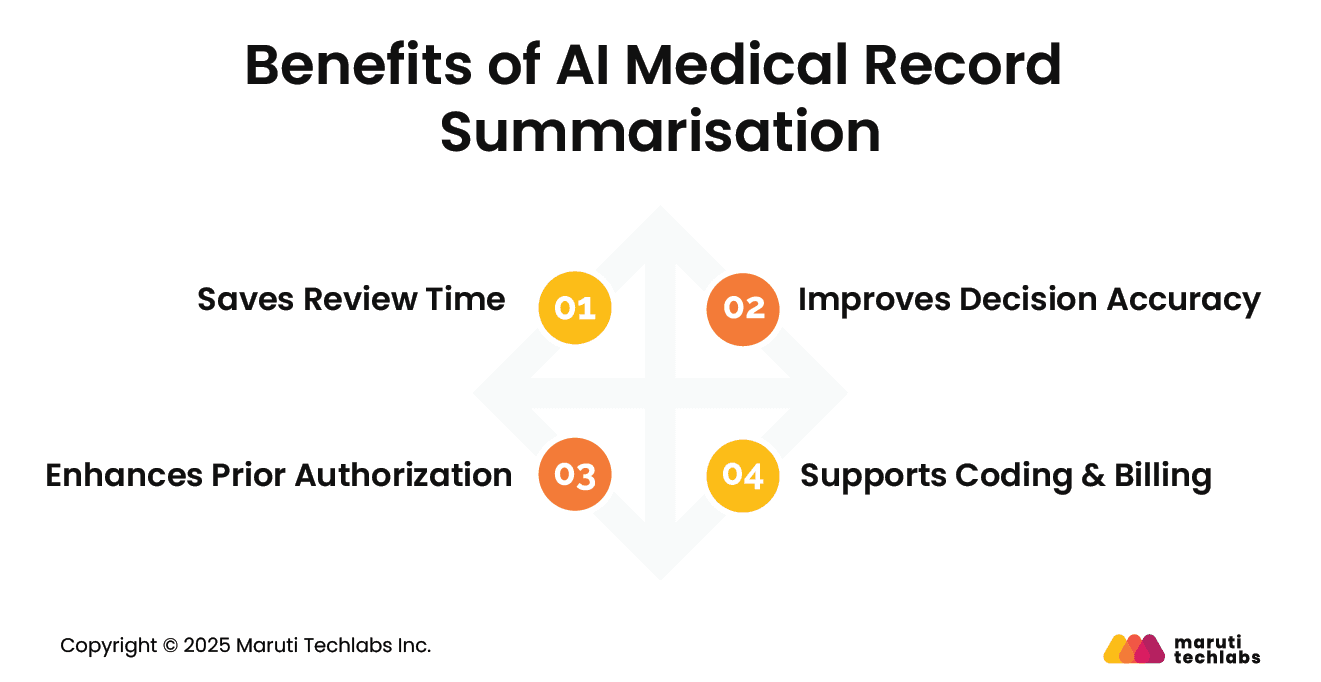
AI tools reduce documentation effort by a considerable margin, with ambient‐scribing systems. This frees clinicians to spend more time with patients and less on manual note‑taking, improving productivity and satisfaction.
As per a study in Nature Medicine, 45% of the summaries from the best-adapted large language models were equivalent to and 36% of them were superior to those from medical experts. Enhanced accuracy supports sound clinical decisions and reduces diagnostic omissions.
AI summarisation integrates with coding workflows, reducing billing errors and increasing precision. NLP tools have cut coding errors by 29%, supporting faster reimbursements and streamlined revenue-cycle management.
Automated summaries capture key clinical context for prior authorisation and insurance purposes. AI-assisted chart reviews speed claims processing by 22% and improve clarity during prior auth reviews, reducing denials and administrative delays.
Though summarizing medical records has several benefits, they have their challenges. Even automated summary generation for medical records is not 100% accurate.
Some of the most common issues with summarizing medical records include:
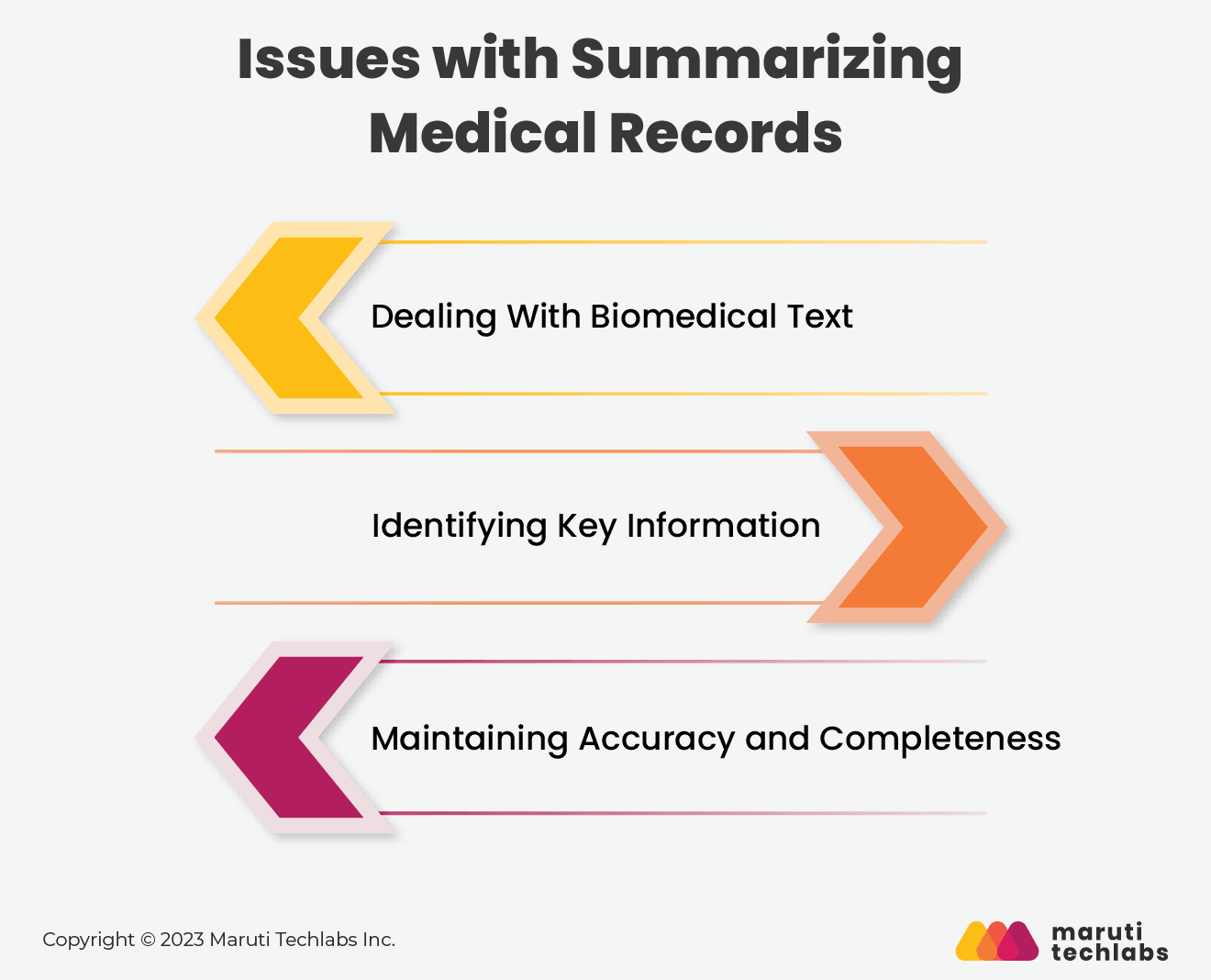
Summarizing biomedical texts can be challenging, as clinical documents often contain specific values of high significance. Here, lexical choices, numbers, and units matter a lot. Hence, creating an abstract summary of such texts becomes a significant challenge.
Medical records contain a large amount of information. But the summary must only include relevant information that aligns with the intended purpose. Identifying and extracting relevant information from medical records can be challenging.
The medical records summarization process must include all the key components of a case. The key features include:
Maintaining accuracy and completeness, in summary, could be a challenge considering the complexity of medical documents.
AI summarisation supports multiple critical workflows across clinical and administrative domains. It makes healthcare operations leaner and decision-making sharper.
Here are key applications enabling faster interpretation, smoother workflows, and improved outcomes.
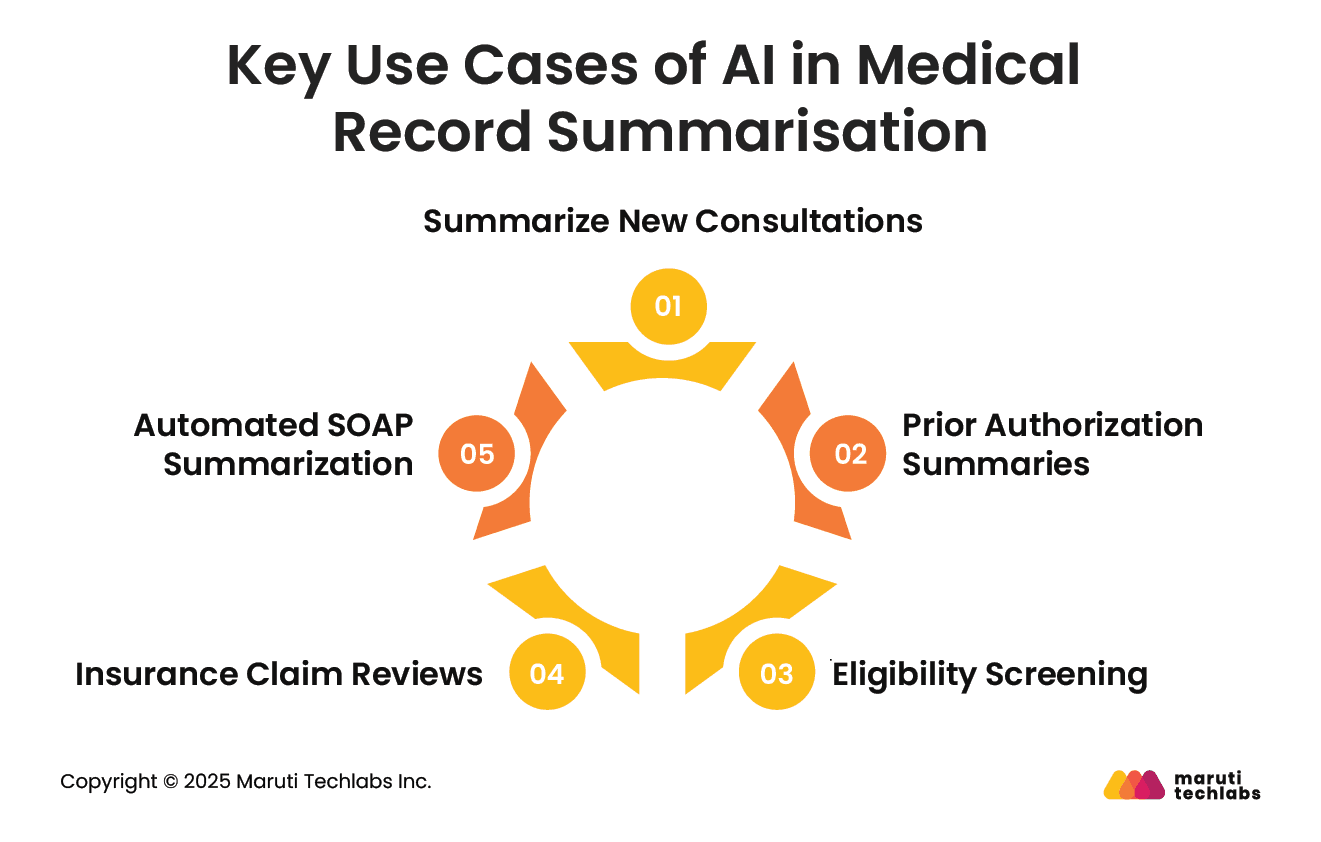
When a patient arrives for a consultation, AI generates a concise summary, highlighting history, medications, diagnoses, and lab results. Clinicians review key facts quickly, reducing prep time significantly and enhancing visit efficiency.
AI creates tailored summaries of relevant clinical evidence needed for prior authorisation, extracting diagnosis, treatment history, and documentation. With this, it supports insurer review, thus speeding approvals and reducing administrative back‑and‑forth.
AI scans patient charts to flag potential trial candidates by matching inclusion/exclusion criteria. Automated summarisation helps pre‑screen eligibility faster, reducing manual chart review time and improving clinical trial enrolment accuracy.
For claims adjudication, AI generates summaries that highlight coded diagnoses, treatment timelines, and supporting documentation, facilitating faster review, error detection, and streamlined processing by payers.
AI distills Subjective, Objective, Assessment, and Plan elements from free‑text encounter notes into structured SOAP summaries, enabling physicians and care teams to review patient status and care plans efficiently.
Despite its promise, AI summarisation faces real-world obstacles that must be addressed for safe and effective adoption in clinical workflows. Here are 4 challenges organizations face while implementing.
Managing protected health information requires strict adherence to HIPAA or GDPR. Many AI providers process data off‑site, raising risks unless encryption, consent, and data‑minimisation protocols are enforced.
Summaries must capture clinical nuance without misinterpretation. Errors in summarised history, lab trends, or medication changes can compromise decision-making, requiring rigorous clinician oversight and validation.
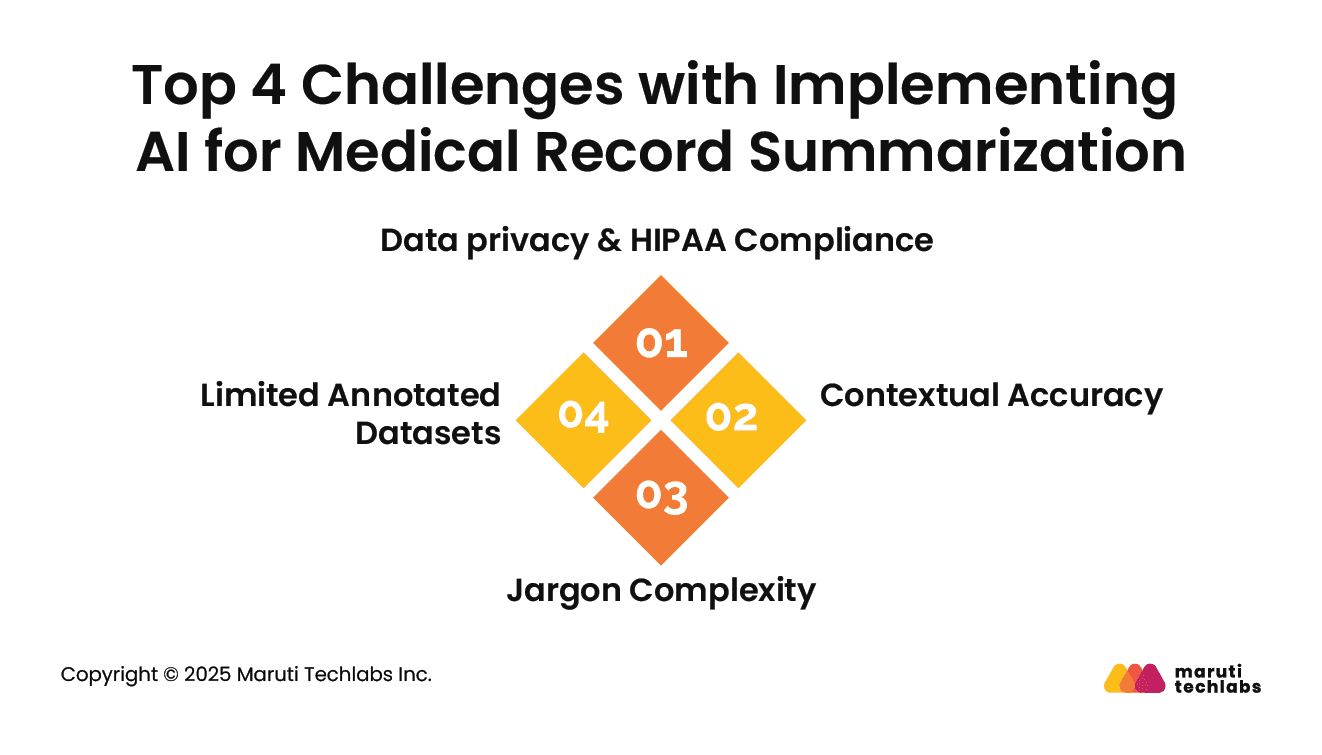
EMRs contain specialty-specific abbreviations, complex terminology, and variable phrasing. Parsing these reliably challenges general LLMs and demands domain‑specific training and vocabulary support.
High-quality labeled medical data for summarisation tasks is scarce, hindering robust training. Development depends on time‑consuming clinician annotation, slowing progress and limiting performance generalization.
Key innovations and ecosystem integrations will shape AI summarisation’s trajectory in healthcare going forward. Here is what the future of AI in healthcare looks like.
Deeper embedding into major EHR platforms (e.g., Epic, Cerner) will enable seamless summarisation within workflows, eliminating copy‑paste and enhancing clinician adoption.
Domain‑specialized models like Med‑PaLM 2 and BioGPT offer improved accuracy and clinical relevance, raising summarization quality and contextual understanding in medical narratives.
Ambient‑listening AI scribes will generate live summaries as clinical encounters unfold, speeding documentation, enriching patient interaction, and enabling on‑the‑fly decision support.
Optical Character Recognition (OCR) is an innovative software tool that can convert different types of documents into editable and searchable files. OCR plays a critical role in medical records summarization. The medicolegal industry involves intensive paperwork, from a patient's history to diagnostic reports, doctor’s prescriptions, and treatment notes. Skimming through this enormous amount of paperwork is time-consuming and cumbersome, and the chances of errors and misplacements are also high. That’s where OCR comes into play.
OCR automates data extraction from scanned documents and converts them into editable and searchable text.
Legal document management with OCR can transform how legal firms handle data. With OCR, you can easily convert law books, medical images, scanned documents, or hand-written prescriptions into an editable text file.
OCR brings many benefits to legal firms. OCR has revolutionized the legal industry, from saving time and cost to improving accuracy and efficiency.
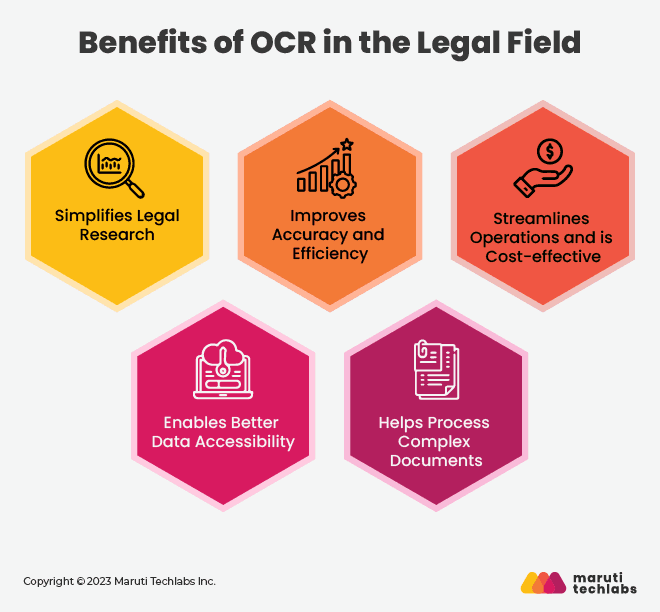
OCR facilitates fast and efficient legal research. The tool converts scanned texts, documents, and photographs into simple, searchable, hand-typed text. A simple search can easily retrieve a plaintiff's name, case record, judgment, or legal clause in a 500-page document.
With OCR, legal professionals don’t have to spend hours sorting, typing, and skimming paperwork. They can use this time to scrutinize the evidence and build the case. OCR also improves accuracy by eliminating human errors and the misplacement of crucial documents.
OCR digitalizes your data. With everything fitting into your digital machine, you don’t need any paper, substantial physical space, or a workforce to handle case files, legal books, and records. It also reduces costs incurred in printing, storing, or shipping documents.
OCR enables quick accessibility of information through any digital medium. Digital data offers a convenient means of sharing information between individuals and locations, especially for legal firms operating across diverse geographic areas with dispersed stakeholders. In addition, digital data transfer eliminates the risk of data tampering and loss.
Manual data entry and basic OCR are inadequate when dealing with intricate document formats, requiring employees to invest significant time in deciphering and extracting relevant information. Advanced AI-powered OCR can accurately recognize and transfer data from various document types, including complex formats.

OCR has emerged as an indispensable tool in the legal industry, and it plays an even more intrinsic role in medical records summarization.
Here are some of the use cases of OCR in the legal industry -
OCR technology is often used to conduct thorough legal research. OCR helps convert paper documents into editable text documents. When you put a scanned copy through an OCR tool, the text becomes editable with a word processor like MS Word or Google Docs.
This makes it easy for legal professionals to search for details using keywords, phrases, or citations within legal materials, including case law, statutes, regulations, and legal opinions. This makes legal research much faster and easier.
OCR is often employed in contract analysis and due diligence processes. It assists in extracting important clauses, provisions, and terms from contracts. OCR enables lawyers to quickly review and assess termination clauses, non-disclosure agreements, and indemnification clauses.
OCR is crucial to generating tons of medical files in digital format. A medical record summarizer uses these files to extract relevant information and create precise summaries. Legal professionals can refer to these summaries, which are written in an easily understandable language. This helps legal firms make informed and accurate decisions.
Handling documents in the legal and medical industries can be error-prone and time-consuming. However, streamlining this process through automation can increase speed, efficiency, and accuracy. Maruti Techlabs has developed a tool called MedBrief, which is an AI-powered medical records summarization system designed for the medical-legal industry.
MedBrief caters to the needs of paralegals and lawyers by providing detailed information such as diagnoses, treatments, and past medical history from various medical documents. The tool uses OCR technology and image analysis algorithms to convert different formats of documents into editable text files and leverage AI and ML technologies to process and summarize medical documents.
With advanced techniques like deep learning and semantic analysis, MedBrief extracts relevant information from various medical documents, including handwritten notes, typed reports, and medical images. The system can flag discrepancies and highlight crucial data points in the summary while providing hyperlinks leading to the source documents.
MedBrief significantly reduces the time taken to organize and review medical records, improving overall efficiency and productivity by reducing manual dependencies and human errors.
Contact us today to leverage the power of technology and streamline your bulky medical records.
Medical records summarization is revolutionizing the healthcare and legal industries. The summarizer analyzes tedious stacks of medical records and creates a concise summary that contains relevant hyperlinks referring to source documents.
Medical records summarization tools leverage OCR technology that helps convert images, handwritten notes, or scanned documents into editable and searchable text. From diagnosis to treatment, prescription to doctor's note, and discharge summaries, all critical information is converted into searchable digital text. This makes it easier for medical and legal professionals to store, access, and research relevant information.
While OCR converts paper texts into editable digital documents, AI-powered medical records summarization helps sort and extract essential information from this data. A medical summary includes details describing the accident or illness, the patient’s condition, diagnosis, and immediate care. The summary also describes the detailed course of the doctor's actions, treatment choice, and outcome. Such outlines form the essence of resolving personal injury, medical malpractice, or negligence cases.
Many legal firms and healthcare institutes have already realized the benefits of outsourcing medical record summary services. Automation in medical document processing is the key to saving time, resources, and costs.

